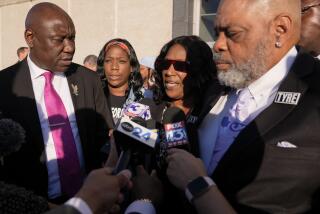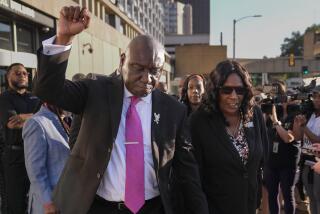Nichols’ Attorney Cuts Short Sentencing Case
- Share via
DENVER — Overwhelmed by three days of devastating testimony from survivors and relatives of the dead in the Oklahoma City bombing, the lead attorney for convicted conspirator Terry L. Nichols pleaded Friday with a federal judge to dismiss the jury and decide himself whether Nichols should live or die for his role in the most horrendous American act of terrorism.
His request denied, lawyer Michael E. Tigar quickly called only nine witnesses--many of them family members--to take the stand and beg for Nichols’ life. And then, just as abruptly, he ended his defense case.
The sudden, unexpected chain of events means the jury, which already apparently has mixed views about Nichols’ role in the 1995 blast, will begin deciding his fate as early as Monday.
“This is enough,” Tigar told the judge, saying the 55 government witnesses who came to court here this week had unfairly prejudiced the jury against his client with their tears, sobs and heart-wrenching stories of lost grandparents, dead babies and lives forever shattered.
Nichols, 42, was convicted last week of conspiring with Timothy J. McVeigh in the April 19, 1995, bombing of the Alfred P. Murrah Federal Building, which left 168 people dead and more than 500 injured.
Tigar had originally advised the court that he had 60 witnesses of his own to bring to court over two or three days in order to help balance out the dreadful stories from the victims.
But as the week wore on, he was heard condemning this sentencing phase of the trial as “sadistic,” and he decided instead to cut it off.
During the three days of testimony from the nearly five dozen victims, Nichols showed no emotion. But he removed his glasses several times Friday and wiped away tears as the nine witnesses testified that he was a good father and husband, and that he was not the type of man to wish harm on anyone.
Nichols’ wife, Marife, told the jury of seven women and five men how, even in prison, her husband has tried his best to help raise their two young children, including a son, Christian, born after his father’s arrest two days after the bombing.
She said he sometimes makes flashcards for the children to help them learn the alphabet. For a while, when he was not allowed to have sharp objects, such as pens or pencils, in his cell, he used blue toothpaste to make bright drawings on the cards he sent Christian and the couple’s daughter, Nicole.
Looking at one of the cards he sent Nicole, Marife Nichols read the inscription: “To Daddy’s Little Angel.”
Nichols’ oldest brother, Leslie Allen Nichols, described their lives growing up on a farm in Michigan, attending a one-room schoolhouse and learning to drive a tractor at the age of 8.
Leslie Nichols also told of the welding accident in 1974 that gave him third-degree burns and left his face terribly disfigured. Afterward, when he needed skin grafts, his brother was willing to help by offering his own “blood and skin,” he said.
But the doctors told Terry Nichols he could not be a donor because he “was not an identical twin,” his brother said.
Under questioning from assistant prosecutor Beth Wilkinson, Leslie Nichols acknowledged that he and his brother sometimes used “fertilizer and dynamite” to blow out tree stumps on the farm--a clear reference to bring home for the jury Terry Nichols’ long familiarity with homemade explosives.
*
Terry Nichols’ sister, Suzanne McDonnell, also talked about farm life raising corn and wheat. She showed the jury a picture of a teenage Terry Nichols feeding a fawn. The animal had been slightly injured when another brother, James, hit it with the tractor. The whole family then adopted the deer and named it “Jeanie,” she said.
“We brought it home and we got it nursed back to health, and so we raised it,” she said. “And many occasions we’d have it in the house.
“She loved apples, and on Sundays she always had pancakes and applesauce with our Sunday breakfast.”
It was the testimony of Lana Padilla, Terry Nichols’ first wife, and her recollections of their son, Josh, now 15, that most clearly moved Terry Nichols and brought forth his tears.
She spoke of his many attempts to make a go at life: farming, the real estate business, the Army. Since his imprisonment, she said, he has frequently telephoned Josh at home in Las Vegas, trying to keep up on his activities.
“Terry was not an imaginary father,” she said. “Terry is the most important person in Josh’s life.”
She said Terry Nichols reviews their son’s grades in school, often encouraging him to do better in math, reading and writing. “Life is darn tough,” he once wrote his son from prison.
In a card for Josh’s last birthday, he told him that the most important thing in life was to use his head.
“You can succeed in anything you put your mind to,” he wrote. “And remember: What a man thinks, so is he. So keep good thoughts always. Love, Dad.”
But before Padilla left the witness stand, Larry Mackey, the chief prosecutor, asked her about another way Terry Nichols helped counsel their son. In the years before his arrest, she conceded, he taught Josh how to build bottle bombs and other small explosives.
In his unsuccessful motion to have the judge take over the penalty decision, Tigar singled out two government witnesses for his sharpest criticism.
He recalled Kay Ice Fulton, who glared at the jurors and reminded them that her slain brother, Paul Ice, a federal law enforcement officer, had once sworn to protect this country and “everyone in this courtroom.”
And Tigar mentioned Kathleen Treanor, who in describing the deaths of her husband’s parents and her 4-year-old daughter, had screamed and pounded the witness stand in an anger that shook the courtroom.
Tigar also said that right after Treanor testified, a woman in the spectator section of the courtroom, identified as Treanor’s sister, told Nichols’ sister, McDonnell: “I hope they go through hell with that.”
Tigar then told U.S. District Judge Richard P. Matsch that the government’s marshaling of victims to plead for Nichols’ death was calculatingly “designed to summon up a call for vengeance.”
“I have been in Versailles when the Vichy collaborators were tried,” said Tigar, one of this country’s most prominent defense lawyers over the last three decades.
“I have been in South Africa alongside my comrades in the apartheid days, as they were tried. I have seen trials in revolutionary Cuba. I’ve tried a case in a little Florida courthouse where we worried that the deputy wouldn’t protect our client from the danger of being lynched.
“But I’ve never seen anything like this.”
Matsch listened patiently, then crisply turned down Tigar’s request in one short sentence. “Well,” he said, “I’m going to deny the motion and rely on the jury.”
While convicted of one conspiracy charge, Nichols was acquitted of charges of actually using the bomb and destroying the building. In addition, the jury passed over charges of first-degree murder in the deaths of the eight federal officers killed that day, including Paul Ice, and instead found Nichols guilty only of involuntary manslaughter.
*
Because of the conspiracy conviction, Nichols now faces death by lethal injection or life in prison with no hope of release.
But if the jury cannot reach a unanimous decision, Matsch must give Nichols either the life sentence or a fixed term of years that would be shorter than life.
In contrast, McVeigh was found guilty in June on all 11 of the same charges and sentenced to death.
But McVeigh clearly was the mastermind of the bombing. He rented the Ryder truck used in the attack and drove it to Oklahoma City.
The government’s evidence against Nichols showed that he helped McVeigh purchase and store the bomb ingredients, and it suggested that he also joined McVeigh in mixing the ammonium nitrate and fuel oil and placing it in the back of the truck.
Times staff writer Louis Sahagun contributed to this story from Denver.
More to Read
Sign up for Essential California
The most important California stories and recommendations in your inbox every morning.
You may occasionally receive promotional content from the Los Angeles Times.











